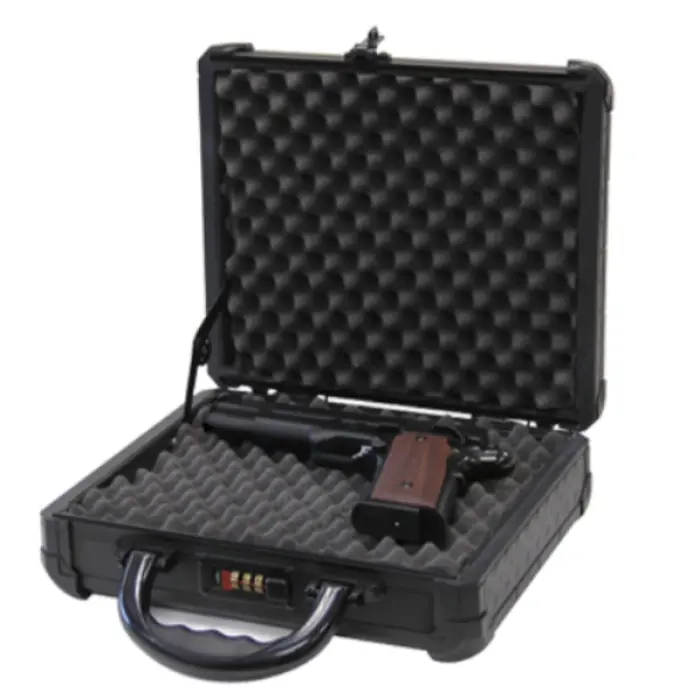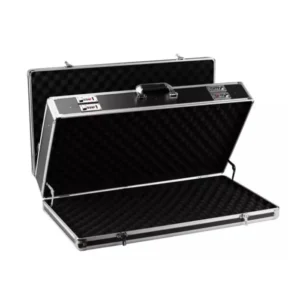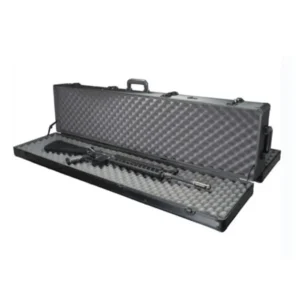The Best Foam for An Aluminum Gun Case

Quality foam is crucial for aluminum gun cases because it provides the necessary protection to keep firearms secure and damage-free during storage and transport.
Without the right gun case padding, firearms can shift, leading to scratches, dents, or even more significant damage.
A well-chosen foam ensures that guns remain in place, cushioned from impact, and protected from environmental factors like moisture and dust.
What is the Best Material for a Gun Case?
When choosing the best material for a gun case, aluminum is a top contender. An aluminum gun case is not only durable but also lightweight, making it ideal for transporting firearms safely.
The robustness of aluminum offers excellent protection against external impacts, while its resistance to corrosion ensures longevity.
An aluminum rifle case, for instance, is particularly suited for those who need a reliable and sturdy case to protect their valuable firearms.
What is the Best Material to Line a Gun Case With?
The interior lining of a gun case is just as important as its exterior material.
The best material to line a gun case with is foam, which provides cushioning and support for firearms.
Gun case foam is essential because it prevents movement within the case, reducing the risk of damage during transport.
The foam must be chosen carefully, considering factors like moisture resistance, firmness, and durability to ensure it meets the specific needs of the firearm and the conditions it will be exposed to.
Best Foam for Gun Cases
#1. Polyurethane Foam (PU)
Polyurethane foam is a common choice for gun case padding, but it has its drawbacks.
While it is more affordable than other options, it is an open-cell foam, which means it can absorb liquids like oil and cleaning solvents.
This absorption can lead to rust on firearms and cause the foam to break down over time, losing its original shape.
Despite its cost-effectiveness, PU foam may not be the best option for those looking to maintain their aluminum rifle case in optimal condition over the long term.
#2. Ethylene-Vinyl Acetate Foam (EVA)
EVA foam is a closed-cell foam, known for its rigidity and smooth finish. It is a premium choice for gun case foam, offering excellent support and durability.
However, it is less common due to its higher cost compared to other foams.
EVA foam is a suitable option for those who need a highly durable and supportive lining for their gun case, though its rarity and price may make it less accessible for all gun owners.
#3. Polyethylene Foam (PE)
Polyethylene foam, or PE foam, is often considered the best choice for lining an aluminum gun case.
It is a closed-cell foam, meaning it does not absorb moisture, which is critical for preventing rust and other forms of moisture-related damage.
PE foam is also firm and supportive, ensuring that firearms remain securely in place.
For those looking to display their firearm, cross-linked polyethylene foam offers a high-end, visually appealing look, making it ideal for a rifle case with foam.
Although it is pricier than other options, its durability and moisture resistance make it a worthy investment for protecting valuable firearms.
How to Cut Foam for Gun Cases
Cutting foam for gun cases requires precision to ensure a snug fit for the firearm.
Step 1
Outline the shape of the gun on the foam using a marker.
Step 2
Use a sharp knife or a specialized foam cutter to follow the outline carefully. It’s important to cut slowly and steadily to avoid uneven edges.
For more complex shapes, consider using a hot wire foam cutter, which can offer more control and precision.
Step 3
Once cut, place the foam inside the aluminum gun case, ensuring the firearm fits securely within the padding.
Properly cut foam not only enhances the appearance of the case but also maximizes the protection of the firearm during transport and storage.



